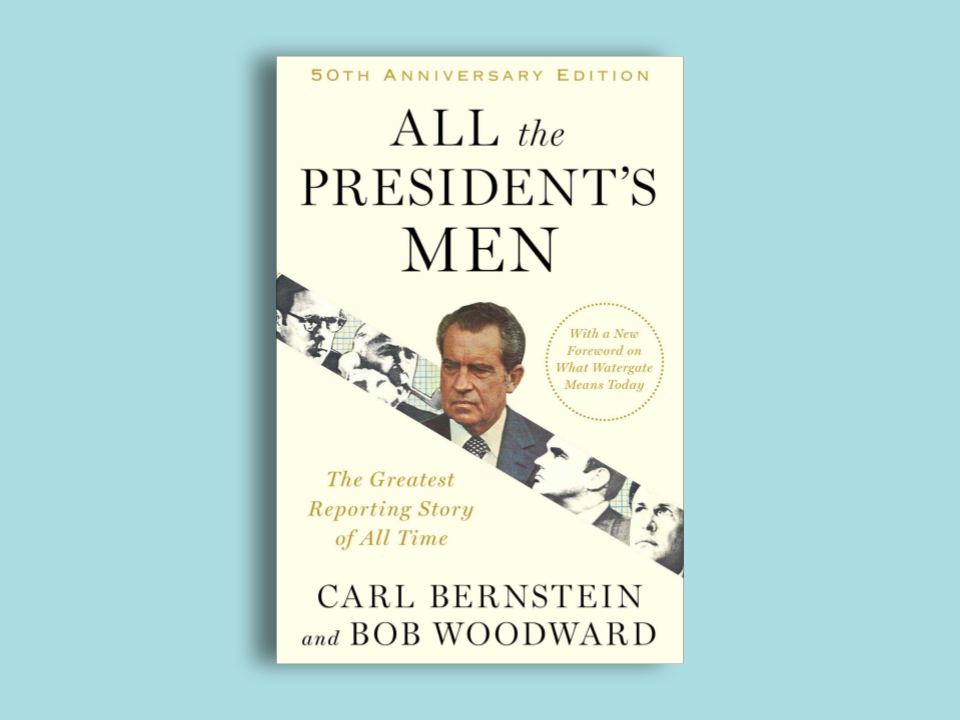A Blueprint for the Future
“All the President’s Men” is a journalistic thriller and a roadmap for the future of reporting.

Reading “All the President’s Men,” one might be forgiven for thinking they’re deep in the pages of the Washington Post. The book, written by former Post reporters Bob Woodward and Carl Bernstein, reads like a piece of long-form news analysis, recording and analyzing every aspect of the Watergate story in excruciating detail.
Set amidst the Byzantine politics and general skullduggery of late 1960s and early 1970s Washington, “All the President’s Men” is the definitive account of the Washington Post’s investigation into the Watergate scandal. As the Post’s principal Watergate reporters, Woodward and Bernstein are the stars of the show. The book documents their countless interviews, phone calls, and clandestine meetings that helped to expose the truth of the Nixon campaign’s election meddling and spying. Thanks to a administration chock-full of cloak-and-dagger dealings and larger-than-life characters, the book reads like a spy thriller, minus the exciting helicopter chases.
Cracking open a copy of “All the President’s Men,” readers are greeted with a very, very thorough “Cast of Characters,” a brief preview of the many colorful characters involved in the Watergate affair. At first, I was a little skeptical of this reading roster’s usefulness. I will even admit that my naïve pre-book self may have actually laughed a bit flipping through these pages. What kind of person needs directions for reading?
Apparently, I do.
Unfortunately, by the time I figured that out, I was already too far gone to save myself from drowning in the sea — and I mean sea — of names. Consider this quote, which spans just four lines on page 70: “‘I don’t know if he ever worked for Nixon,’ he said, ‘I don’t have any proof. He could have been working for Kennedy, Muskie or Sam Yorty, for all I know.’ But Segretti had told Shipley that if he stayed with the operation, it would lead to a permanent job in the administration.”
"These aren’t in fact all of the president’s men, but it sure doesn’t seem like they missed more than a couple."
Who are these people? Some I know, and some are rather important. But Sam Yorty? This is the only time he shows up in the entire book! Was that really necessary?
The book may be a bit hyperbolic when it comes to the title — these aren’t in fact all of the president’s men — but it doesn’t seem like they missed more than a couple of them. Some might find that note-taking is their only chance of understanding, but others (like myself) might grimace at the idea of the pages of writing you’ll need to reach any level of understanding.
Luckily, for those of us unwilling to break out the notepad, there’s a movie! Literary traditionalists may disparage this approach, but — believe me — it’s a necessity. If you’re looking to preserve some shreds of reading dignity, treat the movie as a refresher course for chapters you’ve already read, helping to brush up on some of the finer points of the investigations.

I’m officially done griping about the names (probably). And thankfully for readers, once you get past the countless mentions of Parkinsons, Baldwins, and Butterfields, and Shumways (all names that I found in the “Cast of Characters” and had no memory of), “All the President’s Men” is, to put it quite simply, a pretty good book.
And for reporters and media nerds everywhere, this book is a pretty great book, and an essential part of both the past, present, and future of journalism.
Especially in today’s fraught, media-undermining times, trust in journalism is more essential than ever.
The historical import is perhaps the most obvious; “All the President’s Men” serves as a record of the heroism of the reporters and sources of the Watergate investigation. It provides a fascinating look at the function and structure of newsrooms in the late 20th century, and the incredible levels of corruption that existed (and still do) in certain public offices. Through “All the President’s Men,” readers can peer into another era of American history, though it’s one that might not be that dissimilar from our own.
In regards to the present day, Woodward and Bernstein’s account of the entire Watergate affair reinforces the value of journalism in American society. Especially in today’s fraught, media-undermining times, trust in journalism is more essential than ever. In the foreword of the 50th anniversary edition, Woodward and Bernstein say that Nixon (and a certain other president) “created a conspiratorial world in which the U.S. Constitution, laws and fragile democratic traditions were to be manipulated or ignored, political opponents and the media were 'enemies,' and there were few or no restraints on the powers entrusted to these two presidents.” Nixon’s press secretary, Ron Ziegler, was particularly focused on disrupting reporting on Watergate. On page 172, Woodward and Bernstein explain that “White House sources confirmed that Ziegler’s statement [on Nixon’s policy on testifying] was nothing more than a public-relations gesture … intended to divert attention from the President’s claim of executive privilege in the Senate investigation.” This situation, and others like it, displays the same tactics of media manipulation, misdirection, and discreditation used by today's politicians.
At risk of turning this book review into a political thought piece, I feel that it’s important to note how Woodward and Bernstein highlight the danger that press restriction causes. At its core, “All the President’s Men” is the story of what happens when politicians refuse to recognize the freedom of the press and intentionally malign journalistic reputations in order to secure their own power.
"For journalists and media nerds everywhere, this book is a must read."
At its most important, “All the President’s Men” is a framework for the future of ethical reporting. By peeling back the layers on the reporting process, the book provides some much-needed humanization of journalism. In today’s media landscape, trust is paramount; it will only continue to become more important in the future. By showing the gritty, difficult, and sometimes messy job of journalists, “All the President’s Men” displays the hard work that goes into accountable reporting, increasing public trust in journalism.
Many journalists have likely read “All the President’s Men” (at least based on the purely anecdotal count of the sheer number of analyses and thought pieces they keep writing, for both the book and the movie). And whether consciously or not, today’s media leaders are following in the footsteps of Woodward and Bernstein, documented decades ago with “All the President’s Men.” Beyond simply reporting the facts themselves, the book explained how the facts were gathered, bringing further credibility and validity to the reporting. Today’s reporters are increasingly doing the same, sharing their journalistic process and documenting the trials and hardships of reporting.
For journalists and media nerds everywhere, this book is a must read. Anyone and everyone interested in the history of journalism, the media world today, or the future of the Fourth Estate should look no further than “All the President’s Men.”
Just make sure to have a notepad handy.



